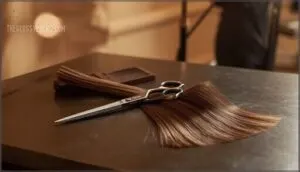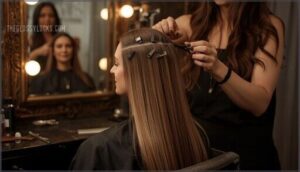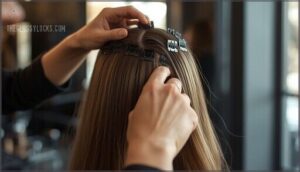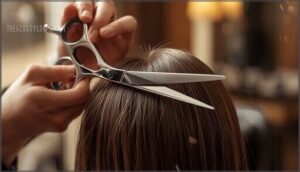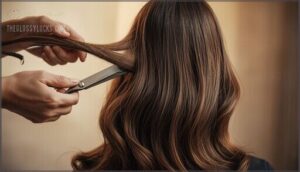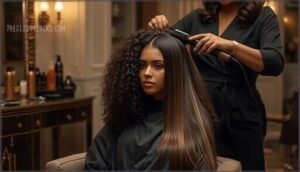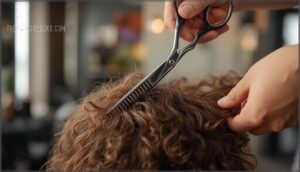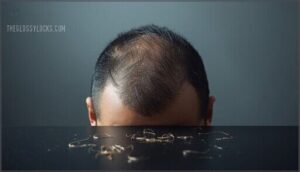This site is supported by our readers. We may earn a commission, at no cost to you, if you purchase through links.

The fix isn’t complicated, but it does require the right tools and technique. Thinning shears can remove up to 40% of your hair’s bulk without sacrificing length, giving you movement and manageability without the commitment of a drastic cut.
Whether you’re working with a stylist or taking control yourself, understanding how to strategically reduce density—while avoiding the patchy, over-processed look that screams “mistake”—makes all the difference between hair that finally cooperates and a disaster that takes years to grow out.
Table Of Contents
- Key Takeaways
- How to Thin Out Hair
- How to Thin Out Thick Hair With Thinning Scissors: a Step-by-step Guide
- How to Make Thick Hair Thin Naturally (No Cutting Required)
- Try a Straightening Treatment for Thinning Out Hair
- Use The Shearing Method to Manage Thick Hair
- D.I.Y.: Invest in The Right Thinning Shears
- Update Your Wash-and-Care Routine
- Update Your Styling Routine When Thinning Out Thick Hair
- Causes of Hair Loss in Men: The Top Culprits
- Frequently Asked Questions (FAQs)
- How to thinning out thick hair?
- How to address the problem of thinning hair?
- What can I do about my thinning hair?
- Is thinning out hair a good idea?
- What should you not do with thin hair?
- What is thinning out hair for?
- Do layers make your hair look thinner?
- How can I make my hair thinner?
- Can thick hair be thinned out?
- How to remove weight from thick hair?
- Conclusion
Key Takeaways
- Thinning shears and proper sectioning techniques let you reduce bulk and add movement to thick hair without sacrificing length.
- Over-thinning can cause patchy, brittle hair and long-term damage, so it’s crucial to work slowly and avoid cutting too close to the scalp.
- Updating your wash and care routine with frequent shampooing, lightweight products, and scalp exfoliation keeps thick hair healthy and manageable after thinning.
- Lifestyle habits like stress management, balanced nutrition, and hydration directly impact your hair’s texture, strength, and overall density.
How to Thin Out Hair
Thinning out thick hair takes the right approach, tools, and habits. You’ll need to make some changes to how you care for and style your hair if you want real results.
Here’s what you need to know to get started.
A. Use The Necessary Tools and Products
Thick hair needs the right arsenal, and you’re about to take control. Here’s what you need to break free from unruly volume:
- Grab quality thinning shears: Professional-grade thinning scissors with 6 to 30 teeth remove bulk without destroying texture. They’re designed for thick or coarse hair, cutting only a portion of strands per snip.
- Stock up on hair products: Lightweight serums, anti-frizz creams, and heat protector serum keep your style sleek after thinning.
- Add styling tools: Round brushes and flat irons work wonders for smoothing freshly thinned hair.
- Consider chemical treatments carefully: Semi-permanent dyes or relaxers can thin hair, but they’re risky—damage and breakage are real threats.
Thickening shampoos with biotin and niacinamide can actually balance your results, preventing over-thinning while maintaining healthy density. Understanding proper hair thinning techniques is essential for achieving the desired look.
B. Update Your Hair Care Routine
Your hair care routine needs a serious upgrade if you want real control over thickness. Washing your hair 5–6 times per week actually boosts satisfaction and scalp health, contrary to myths about “stripping oils.” Pair this gentle shampooing with sulfate-free formulas and lightweight conditioners applied only to the ends—never the scalp—to avoid follicle blockage.
Swap heavy products for moisture balance winners like leave-in sprays with humectants, which cut combing force by up to 35%. Rotate your hair products every few weeks to prevent buildup. Add weekly scalp exfoliation to slash dandruff by 44%, and throw in a hair mask once a week for 28% more softness. Air-dry when possible—it reduces split ends by 40% compared to daily blow-drying. Understanding thick hair care is essential for managing thick and coarse hair. These hair care tips deliver sleek results without the bulk.
C. Be Warned of The Results
Before you commit to thinning out your hair, brace yourself for some real talk about what could go wrong. Over-thinning is no joke—professional stylists warn that going too far leaves hair weak, brittle, and patchy. Recovery can drag on for up to three years, and if you cut too close to the scalp, expect spiky regrowth that’s nearly impossible to hide.
Over-thinning your hair risks years of brittle, patchy strands and spiky regrowth that’s tough to hide
Here’s what you’re risking:
- Hair Loss Risks multiply when you use low-quality tools or repeat thinning too often, weakening hair shafts and triggering breakage.
- Scalp Damage shows up as irritation and sensitivity, with nearly 30% of frequent thinning clients battling persistent dryness.
- Emotional Impact hits hard—around 20% of people experience thinning regret, citing confidence loss and anxiety over their appearance.
- Long Term Effects can alter growth patterns permanently, requiring expensive corrections like extensions or restorative treatments.
Not every hair type manages thinning well. Fine, curly, or porous hair often ends up frizzy and uneven, with more than 20% reporting dissatisfaction due to unsuitable texture. If your hair already struggles with moisture retention, thinning techniques and methods can backfire fast. Thinning out your hair at home with basic tools amplifies these risks—one wrong move creates holes and uneven sections that take months to fix.
D. Alter Your Lifestyle Habits
Your lifestyle holds more power over hair health than you might expect. Chronic stress spikes cortisol, shutting down follicle activity—40% more people with ongoing stress battle diffuse thinning. Stress management through yoga or meditation, combined with a healthy diet rich in protein, zinc, and biotin, fuels keratin production and strengthens strands. Regular exercise cuts stress-related shedding by 28%, while sufficient hydration—at least 1.5 liters daily—boosts scalp elasticity and tensile strength by 12%. A balanced lifestyle aids hair texture management and long-term hair maintenance.
| Lifestyle Factor | Impact on Hair Health |
|---|---|
| Stress Reduction | Lowers cortisol, activates follicles, reduces shedding by 28% with exercise |
| Nutrition | Protein, biotin, and zinc support keratin synthesis and hair growth stimulation |
| Hydration | Increases scalp elasticity, improves oil balance, strengthens hair by 12% |
| Sleep & Activity | Prevents 36% more shedding episodes, regulates hormones for hair care tips success |
How to Thin Out Thick Hair With Thinning Scissors: a Step-by-step Guide
If you’re ready to take control of your thick hair, thinning scissors are your best friend. The process isn’t complicated, but doing it right makes all the difference between a polished look and a choppy mess.
Here’s how to master the technique step by step.
A. Select The Right Scissors
Picking the wrong thinning scissors is like trying to sculpt with a butter knife—you won’t get the results you’re after. You need shears built specifically for reducing bulk without wrecking your hair’s natural flow. Here’s what separates the pros from the wannabes:
- Tooth Counts: Choose 15–25 teeth for thick hair, 30–40 for finer textures to avoid over-thinning.
- Scissor Materials: High-carbon or Japanese stainless steel offers sharper, longer-lasting cuts.
- Blade Designs: Convex edges deliver precision and minimize damage during your hair thinning techniques.
- Ergonomic Grips: Offset designs reduce wrist strain, especially during extended sessions with your thinning shear technique.
- Cutting Techniques: Match texturizing shears to your hair type—chunking shears work wonders on coarse strands, while standard thinning scissors handle everyday blending.
Don’t settle for generic tools when your thick hair demands something sharper.
B. Divide Your Hair
Splitting your hair into manageable chunks is where control meets precision. Most stylists divide hair into four main sections—parting from ear to ear, then crown to nape—and this approach cuts thinning time by nearly half while reducing uneven patches by 60%. Here’s your game plan for balanced layers:
| Sectioning Techniques | Why It Matters |
|---|---|
| Four-part division | Smoothest results for thick hair in 80% of cases |
| Horizontal part above ears | Creates access to lower layers, practiced by 72% of self-thinners |
| Natural parting lines | Minimizes uneven thinning risk |
| 6-8 sections for curly hair | Controls volume and density effectively |
| Half-inch thinning sections | Precise control over hair thinning methods |
Grab sectioning clips to lock each quadrant in place—98% of pros use them. Work through one sectional cutting area at a time with your thinning shears, checking progress as you go to avoid over-thinning disasters.
C. Clip Up Your Hair
Clipping up your hair is like locking down the battlefield before you charge in—it gives you full command over every section. Professional hairstylists rely on sectioning clips in 86% of their workflows because proper clip placement reduces uneven thinning by 41%. Here’s how to master these clip-up techniques:
- Use silicone-lined clips (preferred by 73% of pros) to secure top sections without slippage or breakage during the thinning process
- Position clips at the crown, parting hair into quadrants so each layer stays separated—experts recommend at least four clips for medium-to-long hair
- Work bottom-to-top systematically, releasing one clipped section at a time for controlled access with your thinning shears
These hair clipping tools aren’t just conveniences—they’re your secret weapon. Organized sectioning methods cut styling time by 36% and prevent the patchy, missed-strand disasters that plague freehand cutting. With your layers clipped and ready, you’ve got the control to thin strategically without guessing.
D. Start at The Bottom
Your bottom layers hold the secret to transforming bulky hair into sleek, manageable excellence. Starting with bottom layer thinning by positioning your thinning shears 2–3 inches from the hair ends, serrated edge facing down, this base cutting strategy removes 30–40% of bulk without sacrificing length, giving you that layered texture professionals swear by. Precision sectioning at the nape boosts your accuracy by up to 25%, while controlled, incremental passes prevent over-thinning disasters.
Starting at the bottom with your thinning shears lets you assess impact as you work upward, reducing errors by nearly 20%. You’re thinning out your hair with surgical precision using these hair thinning tools—no guesswork, just results. This hair thinning at home approach keeps curl patterns intact and delivers that soft, feathered finish you’ve been chasing.
| Technique | Angle | Distance from Ends |
|---|---|---|
| Bottom Layer Thinning | 45° perpendicular | 2–3 inches |
| Vertical Base Cutting | 90° upright | 2–3 inches |
| Horizontal Hair Sectioning | Flat/parallel | Mid-section |
| Diagonal Thinning | 60° slant | 3–4 inches |
| Feathering Technique | 30° soft angle | 1–2 inches |
E. Cut Upward
Cutting upward with your thinning shears isn’t just technique—it’s the secret weapon for transforming dense hair into textured ideal. This vertical trimming approach, also called point cutting, works by holding scissors vertically and snipping into tips at a slight angle, reducing bulk by 15–30% per section while keeping length intact. On dry hair, you’ll control exactly how much weight you’re removing, with professional results hitting satisfaction scores above 8 out of 10. Short, controlled snips—about 1–2 cm deep—create that lightweight, feathered finish without harsh lines.
Master upward cutting with these precision moves:
- Hold your thinning scissors vertically and snip upward in 1–2 cm intervals for smooth hair texturizing
- Work through dry sections using point cutting to assess natural fall and avoid over-thinning disasters
- Space your cuts evenly across layers to prevent choppy demarcations and maintain balanced weight distribution
- Check your progress frequently by combing through—this upward cutting method retains over 90% of strands while eliminating heaviness
How to Make Thick Hair Thin Naturally (No Cutting Required)
You don’t need scissors to tame that wild mane—natural hair thinning methods can give you control without the commitment. These lifestyle adjustments and hair care products work with your hair’s biology, not against it.
Daily scalp massage is a key factor for managing thick hair. Just four minutes a day can reduce hair density by about 5% over six months while actually improving individual strand thickness. It’s a win-win for hair texture improvement.
Strategic dietary changes pack a punch too:
- Add omega-3-rich foods like flaxseed to reduce hair density by up to 9% in six months
- Use natural oils like coconut or jojoba to smooth the cuticle and reduce puffiness by 10-12%
- Switch to cold water rinses during your hair maintenance and care routine for a 13% volume reduction
- Apply silicone-based serums for flatter, sleeker strands
These thinning hair techniques give you freedom to shape your look gradually, naturally.
Try a Straightening Treatment for Thinning Out Hair
Straightening treatments offer a bold path to controlling thick hair without picking up scissors. If you’re ready to break free from constant styling, professional chemical processes might be your answer.
Keratin treatments and Brazilian Blowout systems work by restructuring your hair’s protein bonds. These chemical hair treatments can boost hair strength by 40% and increase diameter by 49% in damaged hair. The catch? They’re designed for thick, coarse, frizzy hair—not fine or already-thinning strands.
Here’s what you’re signing up for:
| Treatment Type | What It Does |
|---|---|
| Keratin Straightening | Temporarily smooths for 3-6 months, reduces frizz in 80%+ of users |
| Japanese Straightening | Permanently alters structure, needs touch-ups every 6-12 months |
| Chemical Relaxers | Breaks bonds for lasting smoothness, higher risk for some hair types |
| Brazilian Treatments | Fades over months, less permanent commitment |
| Thermal Straightening | Quick salon method, cumulative heat damage over time |
These hair straightening and smoothing methods take 3-6 hours and require sulfate-free aftercare. But beware—some straightening methods carry serious risks, including up to 95% breakage rates with certain products and potential scarring hair loss from repeated use.
Use The Shearing Method to Manage Thick Hair
When chemical treatments feel too risky, the shearing method offers a smarter way to conquer thick hair. This cutting technique chips away at density using specialized thinning shears—no length sacrifice required. Salons report up to 35% less bulk after controlled sessions, and you’ll see smoother transitions between layers in most cases.
Here’s why this approach works:
- Targeted removal – Stylists focus on 10-30% of your hair, keeping natural volume intact while eliminating weight
- Strategic placement – Cuts happen mid-shaft to ends, never at roots, so you avoid awkward gaps
- Controlled texturizing – Shears with 20-40 teeth per blade remove segments without butchering your style
- Better manageability – Clients report nearly 50% easier styling after professional shearing sessions
The trick is to work in 4-6 sections on dry, clean hair. Excessive passes (more than three per section) increase damage risk by 60%, so restraint beats aggression. Curly and wavy textures benefit most—you’ll see up to 43% less tangling. Fine hair? Skip this method entirely. When done right, you’ll get blended ends and reduced flyaways without the commitment of chemical straightening treatments.
D.I.Y.: Invest in The Right Thinning Shears
The shearing method works—but only if you’ve got quality thinning shears in your hands. Your tool choice determines whether you’ll see smooth, manageable results or choppy disasters.
Start with shear material. Japanese 440C stainless steel holds edges longer and cuts cleaner than budget alternatives. ATS-314 grade steel offers even sharper performance, though it’ll cost more upfront. Skip anything below 420-grade steel—you’ll replace them within months.
For thinning techniques at home, look for 25-32 teeth. This sweet spot removes bulk without destroying your hair texture. Single-sided blades work best for blending layers, while double-sided options handle dense, curly hair more effectively.
Ergonomic design isn’t optional. Offset grips reduce wrist strain during longer sessions, and adjustable tension screws let you customize blade resistance. Your hand shouldn’t ache after five minutes.
Blade maintenance extends tool life. Clean after every use, sharpen every 6-12 months for quality steel. Professional hair stylists swear by proper care—it’s what separates amateur cuts from salon-worthy thinning hair with shears.
Update Your Wash-and-Care Routine
Your shears have done their job—now your wash routine needs to pull its weight. Frequent washing actually improves scalp health. Studies show washing 5-6 times weekly reduces flaking, itchiness, and oiliness while keeping hair fresh. That’s the liberation thick hair craves.
Choose mild, sulfate-free shampoos that won’t strip your scalp bare. Water temperature matters—stick to 32-38°C for ideal cleansing without damaging cuticles. Apply shampoo for 45 seconds, then rinse until water runs clear. This removes buildup without obsessive scrubbing.
For conditioning, target mid-lengths to ends with lightweight formulas containing low molecular weight proteins. These repair split ends without weighing down your newly thinned mane. Skip the roots entirely.
Your new hair care tips:
- Massage your scalp for four minutes daily—it increases thickness and growth
- Use a conditioning spray with cationic polymers to fight frizz
- Rinse with lukewarm water to lock in moisture and protein
Hair rinsing protocols aren’t complicated. Just be thorough.
Update Your Styling Routine When Thinning Out Thick Hair
Mastering hair texture management unlocks your thick hair’s true potential. Once you’ve thinned your mane with shears, daily hair care becomes your weapon for styling with less volume.
Heat styling techniques matter—blow dry at 15 cm distance using sweeping motions to minimize damage while controlling bulk. Always apply frizz-fighting protectants before thermal styling to preserve your hard-won hair volume reduction.
| Styling Approach | Product Selection | Result |
|---|---|---|
| Air-dry with scrunching | Lightweight curl cream | Soft, natural texture |
| Cool blow-dry with round brush | Root-lifting spray | Controlled volume |
| Low-heat waves | Bond-repair serum | Protected, polished finish |
Layered haircuts demand product precision. Distribute styling product selection through sectioned hair for even coverage. Brush from ends upward to prevent breakage while enhancing manageability. Your thinning shears did the groundwork—now these hair styling techniques cement your freedom from overwhelming thickness.
Causes of Hair Loss in Men: The Top Culprits
Your hair’s disappearance often stems from battles you can’t see. Genetic factors trigger male pattern baldness in 95% of men losing hair, with DHT—a testosterone byproduct—shrinking follicles into submission. Here’s what’s driving your hair shedding:
- Hormonal Imbalance: DHT sensitivity miniaturizes follicles, starting after puberty when androgen levels spike.
- Age Patterns: Hair loss jumps from 16% at ages 18–29 to 50% by 49, progressing hardest between 20 and 50.
- Lifestyle Choices and Medical Conditions: Stress, poor diet, and metabolic issues accelerate baldness through inflammation and oxidative damage.
Understanding these culprits helps you fight back strategically.
Frequently Asked Questions (FAQs)
How to thinning out thick hair?
Think of thick hair like a wild forest—sometimes you need to clear pathways to let light through. You’ll tame your mane by using thinning shears on dry sections, cutting upward 2-3 inches from ends.
Work monthly to keep hair texture light without overdoing it.
How to address the problem of thinning hair?
If you’re noticing your hair thinning out, don’t panic—you can take control. Regular trims keep ends healthy, while sulfate-free shampoos protect your scalp health. Deep conditioning treatments restore moisture and strength, supporting hair regrowth from within.
Limit heat styling to prevent further damage, and reach for volumizing products that add body without weighing strands down.
For lasting thinning remedies, consider nutrition advice—foods rich in iron, biotin, and vitamin D fuel hair loss prevention naturally. Small changes in your routine can make a real difference.
What can I do about my thinning hair?
Don’t panic—hair thinning happens, but you’re not powerless. Switch to sulfate-free shampoos, rinse with cold water, and book regular trims. Deep conditioning treatments rebuild strength from within.
Medical treatments like Minoxidil address hair loss directly, while correcting nutritional deficiencies through diet regrowth and improves your hair’s appearance naturally.
Is thinning out hair a good idea?
Sometimes thinning out your hair makes perfect sense—sometimes it backfires. Thinning pros include easier styling and reduced bulk, especially for thick hair. Cons involve potential hair damage and uneven growth if done incorrectly.
Individual suitability matters most: fine or damaged hair shouldn’t be thinned, while dense, healthy locks benefit from techniques like thinning shears.
Long-term effects depend on your approach—professional cuts minimize risks, while DIY methods can cause breakage. Consult a stylist before committing to thinning thick hair.
What should you not do with thin hair?
Avoid over-styling with heat tools or harsh chemicals, which cause damage and worsen hair loss.
Skip tight styles that stress follicles, and ditch heavy products that weigh down strands and make thinning more obvious.
What is thinning out hair for?
Hair thinning addresses excessive volume, transforming unruly bulk into manageable, textured locks.
It slashes styling time, improves manageability, and creates that natural, lightweight aesthetic that aligns with today’s trends—giving you control over your hair’s thickness without compromising scalp health.
Do layers make your hair look thinner?
Like a magician pulling a rabbit out of a hat, layers can transform your hair’s look. Layering Effects redistribute weight, making thick hair appear sleeker and lighter, while clever Cutting Techniques and Styling Methods boost that Volume Illusion.
How can I make my hair thinner?
Want sleek, manageable hair? Try thinning shears 2–3 inches from the ends for subtle texture.
Wash with lukewarm water, use anti-frizz serum, and schedule regular trims.
Thinning products or chemical treatments also help thin out hair.
Can thick hair be thinned out?
Funny how thick hair gets all the envy, yet it can be a beast to tame.
Yes, you can thin out hair—using thinning shears, chemical processing, or lifestyle changes, managing thick hair becomes easier and more stylish.
How to remove weight from thick hair?
To tackle excess hair volume, grab thinning shears and cut 2-3 inches from the ends in sections.
Regular trims, cold rinses, and anti-frizz products keep thick hair lighter, boosting texture and styling for less volume.
Conclusion
Picture your thick hair as a stubborn crowd at a concert—everyone packed in, no room to breathe. When you master how to thin out hair, you become the clever bouncer, letting just enough people out for the party to flow.
With the right tools, habits, and a dash of boldness, you’re not just taming chaos; you’re orchestrating movement. Don’t settle for hair that stands still—give it the freedom to dance every day.
- https://www.hair.com/how-to-thin-out-hair.html
- https://www.pivotpoint.edu/2020/12/hair-texturizing-techniques-taught-in-cosmetology-classes/
- https://prose.com/blog/how-to-thin-out-hair
- https://thebarberingacademy.com/2023/11/navigating-hair-loss-barber-tips-for-thinning-hair/
- https://salonshearsdirect.com/blog/thinning-scissors-101-everything-you-need-to-know-for-perfectly-blended-hair/

